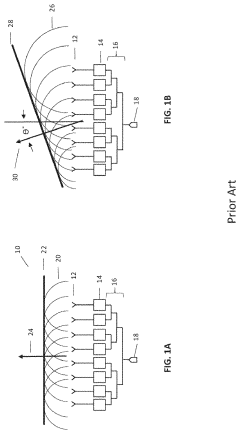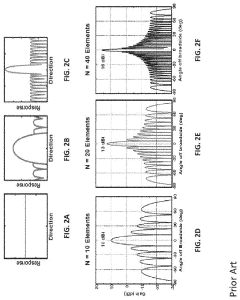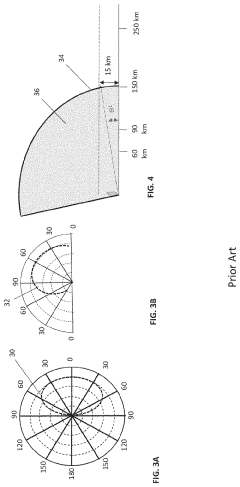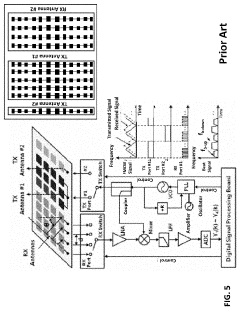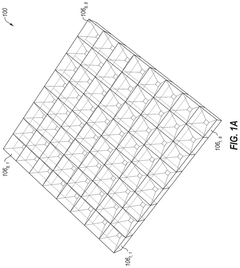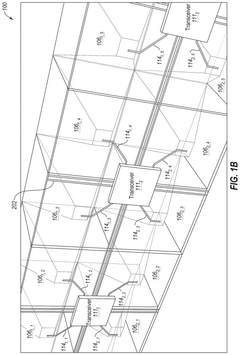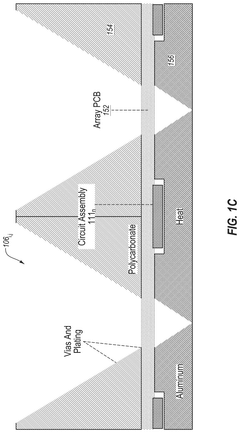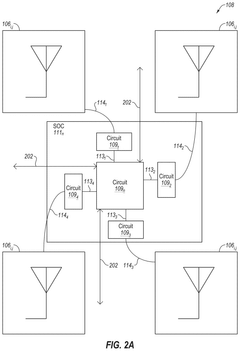Phased Array in Automotive Safety: Compare Responsiveness
SEP 22, 20259 MIN READ
Generate Your Research Report Instantly with AI Agent
Patsnap Eureka helps you evaluate technical feasibility & market potential.
Automotive Phased Array Technology Evolution and Objectives
Phased array technology in automotive safety applications has evolved significantly over the past decades, transforming from basic radar systems to sophisticated sensor arrays capable of real-time environmental mapping. The journey began in the 1970s with military applications, gradually transitioning to commercial automotive use in the late 1990s when adaptive cruise control systems first appeared in luxury vehicles. These early implementations utilized simple phased array configurations with limited beam steering capabilities and relatively slow response times.
The 2000s marked a pivotal shift as semiconductor technology advanced, enabling more compact and efficient phased array systems. MMIC (Monolithic Microwave Integrated Circuit) technology facilitated the integration of multiple transmit/receive modules on single chips, dramatically reducing system size while improving performance. By 2010, automotive phased arrays had evolved to operate at higher frequencies (typically 24GHz and 77GHz), offering improved resolution and detection capabilities.
Current automotive phased array systems represent the culmination of this evolutionary process, featuring sophisticated beamforming algorithms, multiple-input multiple-output (MIMO) configurations, and advanced signal processing techniques. Modern systems operate primarily in the 77-81GHz band, providing exceptional range resolution and angular accuracy. These arrays typically incorporate hundreds of antenna elements, enabling precise beam steering and multiple simultaneous target tracking.
The primary technical objective for automotive phased array systems is to achieve ultra-fast responsiveness while maintaining reliability in diverse environmental conditions. This includes reducing latency in detection-to-decision pathways to sub-millisecond levels, essential for collision avoidance at highway speeds. Another critical objective is enhancing all-weather performance, particularly in conditions like heavy rain, snow, and fog that challenge optical sensors.
Integration with other sensing modalities represents another key evolutionary goal. Modern automotive safety systems increasingly combine phased array radar with cameras, LiDAR, and ultrasonic sensors to create comprehensive environmental awareness. This sensor fusion approach aims to overcome the limitations of individual sensing technologies while leveraging their complementary strengths.
Looking forward, the technology roadmap focuses on achieving higher angular resolution through wider bandwidth operation and more sophisticated digital beamforming techniques. Miniaturization continues to be a driving force, with efforts to reduce system size, weight, and power consumption while increasing functionality. The ultimate objective remains developing phased array systems capable of supporting Level 4 and 5 autonomous driving with response times that match or exceed human reflexes while providing 360-degree situational awareness in all driving conditions.
The 2000s marked a pivotal shift as semiconductor technology advanced, enabling more compact and efficient phased array systems. MMIC (Monolithic Microwave Integrated Circuit) technology facilitated the integration of multiple transmit/receive modules on single chips, dramatically reducing system size while improving performance. By 2010, automotive phased arrays had evolved to operate at higher frequencies (typically 24GHz and 77GHz), offering improved resolution and detection capabilities.
Current automotive phased array systems represent the culmination of this evolutionary process, featuring sophisticated beamforming algorithms, multiple-input multiple-output (MIMO) configurations, and advanced signal processing techniques. Modern systems operate primarily in the 77-81GHz band, providing exceptional range resolution and angular accuracy. These arrays typically incorporate hundreds of antenna elements, enabling precise beam steering and multiple simultaneous target tracking.
The primary technical objective for automotive phased array systems is to achieve ultra-fast responsiveness while maintaining reliability in diverse environmental conditions. This includes reducing latency in detection-to-decision pathways to sub-millisecond levels, essential for collision avoidance at highway speeds. Another critical objective is enhancing all-weather performance, particularly in conditions like heavy rain, snow, and fog that challenge optical sensors.
Integration with other sensing modalities represents another key evolutionary goal. Modern automotive safety systems increasingly combine phased array radar with cameras, LiDAR, and ultrasonic sensors to create comprehensive environmental awareness. This sensor fusion approach aims to overcome the limitations of individual sensing technologies while leveraging their complementary strengths.
Looking forward, the technology roadmap focuses on achieving higher angular resolution through wider bandwidth operation and more sophisticated digital beamforming techniques. Miniaturization continues to be a driving force, with efforts to reduce system size, weight, and power consumption while increasing functionality. The ultimate objective remains developing phased array systems capable of supporting Level 4 and 5 autonomous driving with response times that match or exceed human reflexes while providing 360-degree situational awareness in all driving conditions.
Market Analysis for Automotive Safety Phased Array Systems
The global market for automotive safety phased array systems is experiencing robust growth, driven by increasing consumer demand for advanced safety features and stringent regulatory requirements. Current market valuation stands at approximately 3.2 billion USD in 2023, with projections indicating a compound annual growth rate of 14.7% through 2030, potentially reaching 7.9 billion USD by the end of the forecast period.
Regional analysis reveals North America and Europe as dominant markets, collectively accounting for over 65% of global market share. This dominance stems from early adoption of advanced driver assistance systems (ADAS) and supportive regulatory frameworks. However, Asia-Pacific represents the fastest-growing region, with China and Japan leading implementation efforts, supported by rapid automotive manufacturing expansion and increasing safety consciousness among consumers.
Market segmentation by application shows collision avoidance systems capturing the largest share at 42%, followed by blind spot detection (27%), adaptive cruise control (18%), and other applications (13%). The premium vehicle segment currently represents the primary market, though mid-range vehicles are rapidly incorporating these technologies as manufacturing costs decrease and consumer awareness increases.
Key market drivers include regulatory mandates such as the European New Car Assessment Programme (Euro NCAP) and the National Highway Traffic Safety Administration (NHTSA) requirements in the United States, which increasingly incorporate advanced sensing technologies in safety ratings. Insurance incentives for vehicles equipped with collision avoidance systems further stimulate market growth.
Consumer willingness to pay for safety features has shown significant improvement, with recent surveys indicating 78% of new car buyers consider advanced safety features "very important" in purchasing decisions, compared to 62% five years ago. This shift in consumer perception has accelerated OEM investment in phased array technology integration.
Market challenges include high implementation costs, technical integration complexities, and consumer education gaps regarding system capabilities and limitations. The average cost premium for vehicles equipped with comprehensive phased array safety systems remains between 1,200-2,500 USD, presenting adoption barriers in economy vehicle segments.
Future market trends indicate convergence with other emerging technologies, particularly integration with 5G connectivity, artificial intelligence for improved detection algorithms, and vehicle-to-everything (V2X) communication systems. These integrations are expected to expand the functional capabilities of phased array systems beyond current applications, potentially creating new market segments and revenue streams.
Regional analysis reveals North America and Europe as dominant markets, collectively accounting for over 65% of global market share. This dominance stems from early adoption of advanced driver assistance systems (ADAS) and supportive regulatory frameworks. However, Asia-Pacific represents the fastest-growing region, with China and Japan leading implementation efforts, supported by rapid automotive manufacturing expansion and increasing safety consciousness among consumers.
Market segmentation by application shows collision avoidance systems capturing the largest share at 42%, followed by blind spot detection (27%), adaptive cruise control (18%), and other applications (13%). The premium vehicle segment currently represents the primary market, though mid-range vehicles are rapidly incorporating these technologies as manufacturing costs decrease and consumer awareness increases.
Key market drivers include regulatory mandates such as the European New Car Assessment Programme (Euro NCAP) and the National Highway Traffic Safety Administration (NHTSA) requirements in the United States, which increasingly incorporate advanced sensing technologies in safety ratings. Insurance incentives for vehicles equipped with collision avoidance systems further stimulate market growth.
Consumer willingness to pay for safety features has shown significant improvement, with recent surveys indicating 78% of new car buyers consider advanced safety features "very important" in purchasing decisions, compared to 62% five years ago. This shift in consumer perception has accelerated OEM investment in phased array technology integration.
Market challenges include high implementation costs, technical integration complexities, and consumer education gaps regarding system capabilities and limitations. The average cost premium for vehicles equipped with comprehensive phased array safety systems remains between 1,200-2,500 USD, presenting adoption barriers in economy vehicle segments.
Future market trends indicate convergence with other emerging technologies, particularly integration with 5G connectivity, artificial intelligence for improved detection algorithms, and vehicle-to-everything (V2X) communication systems. These integrations are expected to expand the functional capabilities of phased array systems beyond current applications, potentially creating new market segments and revenue streams.
Current Challenges in Automotive Phased Array Responsiveness
Despite significant advancements in phased array technology for automotive safety applications, several critical challenges persist in achieving optimal responsiveness. The primary limitation stems from the inherent trade-off between scanning speed and resolution. Current automotive phased array systems struggle to maintain high-resolution detection while simultaneously delivering the rapid response times necessary for safety-critical scenarios, particularly at highway speeds where reaction windows are measured in milliseconds.
Signal processing latency represents another substantial hurdle. The computational demands of processing multiple beam signals from phased array sensors create bottlenecks that delay critical safety responses. Even with modern DSP (Digital Signal Processing) architectures, the time required to analyze complex return signals, filter noise, and make actionable determinations introduces delays that can compromise safety margins in emergency situations.
Environmental interference poses significant challenges to phased array responsiveness in automotive applications. Rain, snow, fog, and road debris can attenuate signals and create false returns, requiring sophisticated filtering algorithms that further increase processing time. Additionally, electromagnetic interference from other vehicles' radar systems, urban infrastructure, and communication networks can degrade signal quality, necessitating additional processing overhead for signal disambiguation.
Power consumption constraints in automotive environments limit the available computational resources for phased array systems. While high-performance computing solutions exist, their energy demands often exceed practical automotive power budgets, forcing compromises in processing capability that directly impact system responsiveness. This challenge is particularly acute in electric vehicles where power efficiency is paramount.
Calibration drift represents a subtle but significant challenge to maintaining consistent responsiveness. Environmental factors such as temperature fluctuations, mechanical vibration, and component aging can alter the precise timing relationships critical to phased array operation. Current systems lack robust self-calibration mechanisms that can maintain optimal performance without introducing additional latency.
Integration complexity with other vehicle systems further complicates responsiveness optimization. Phased array sensors must coordinate with multiple vehicle subsystems including braking, steering, and stability control. The communication protocols and arbitration mechanisms between these systems introduce additional latency that compounds the inherent delays in the phased array system itself.
Cost constraints remain a significant barrier to implementing more responsive solutions. While military and aerospace applications have access to high-performance phased array technologies with superior responsiveness characteristics, the automotive industry faces strict cost limitations that restrict the adoption of these advanced solutions, forcing compromises in performance to meet market price points.
Signal processing latency represents another substantial hurdle. The computational demands of processing multiple beam signals from phased array sensors create bottlenecks that delay critical safety responses. Even with modern DSP (Digital Signal Processing) architectures, the time required to analyze complex return signals, filter noise, and make actionable determinations introduces delays that can compromise safety margins in emergency situations.
Environmental interference poses significant challenges to phased array responsiveness in automotive applications. Rain, snow, fog, and road debris can attenuate signals and create false returns, requiring sophisticated filtering algorithms that further increase processing time. Additionally, electromagnetic interference from other vehicles' radar systems, urban infrastructure, and communication networks can degrade signal quality, necessitating additional processing overhead for signal disambiguation.
Power consumption constraints in automotive environments limit the available computational resources for phased array systems. While high-performance computing solutions exist, their energy demands often exceed practical automotive power budgets, forcing compromises in processing capability that directly impact system responsiveness. This challenge is particularly acute in electric vehicles where power efficiency is paramount.
Calibration drift represents a subtle but significant challenge to maintaining consistent responsiveness. Environmental factors such as temperature fluctuations, mechanical vibration, and component aging can alter the precise timing relationships critical to phased array operation. Current systems lack robust self-calibration mechanisms that can maintain optimal performance without introducing additional latency.
Integration complexity with other vehicle systems further complicates responsiveness optimization. Phased array sensors must coordinate with multiple vehicle subsystems including braking, steering, and stability control. The communication protocols and arbitration mechanisms between these systems introduce additional latency that compounds the inherent delays in the phased array system itself.
Cost constraints remain a significant barrier to implementing more responsive solutions. While military and aerospace applications have access to high-performance phased array technologies with superior responsiveness characteristics, the automotive industry faces strict cost limitations that restrict the adoption of these advanced solutions, forcing compromises in performance to meet market price points.
Comparative Analysis of Current Phased Array Response Solutions
01 Beam steering and control techniques
Advanced beam steering and control techniques are essential for improving phased array responsiveness. These techniques involve precise manipulation of phase shifters and amplitude controls to direct the radiation pattern in desired directions. By implementing sophisticated algorithms and control systems, the phased array can rapidly adjust its beam direction and shape, enhancing its responsiveness to changing operational requirements. These methods enable dynamic beam forming capabilities that are critical for applications requiring fast scanning and tracking.- Beam steering and control techniques: Advanced beam steering techniques are essential for phased array responsiveness, allowing precise control of radiation patterns. These systems employ phase shifters and digital signal processing to dynamically adjust beam direction and shape in real-time. Adaptive algorithms optimize beam formation based on environmental conditions and target requirements, enabling rapid scanning across wide angular ranges while maintaining signal integrity and minimizing interference.
- Response time optimization in phased arrays: Optimizing response time in phased array systems involves minimizing latency between command input and beam redirection. This is achieved through high-speed electronic components, efficient signal processing architectures, and parallel processing techniques. Advanced systems incorporate predictive algorithms to anticipate required beam positions, reducing effective response times. Hardware acceleration and specialized integrated circuits further enhance responsiveness by streamlining the signal path from control inputs to phase shifter adjustments.
- Calibration and error correction systems: Maintaining phased array responsiveness requires sophisticated calibration and error correction systems to compensate for component variations and environmental factors. These systems employ feedback mechanisms to continuously monitor array performance and adjust phase and amplitude settings accordingly. Self-calibration routines can detect and correct for temperature drift, component aging, and manufacturing tolerances. Advanced error correction algorithms use reference signals to identify and mitigate phase errors, ensuring consistent beam formation and steering accuracy over time.
- Modular and scalable phased array architectures: Modular phased array architectures enhance responsiveness by allowing flexible configuration and scaling of array elements. These designs feature standardized interfaces between components, enabling rapid reconfiguration and maintenance. Distributed processing approaches distribute computational load across multiple controllers, maintaining responsiveness as array size increases. Hierarchical control structures optimize command distribution, allowing subsections of large arrays to respond independently when needed while maintaining coherent operation for full-array functions.
- Integration of advanced materials and manufacturing techniques: The integration of advanced materials and manufacturing techniques significantly improves phased array responsiveness. Gallium nitride and silicon carbide semiconductors enable higher power handling and faster switching speeds. MEMS-based phase shifters reduce size while improving response time. 3D printing and advanced packaging technologies allow for more compact integration of RF components, reducing signal path lengths and associated delays. These innovations collectively enable more responsive arrays with improved thermal management and reduced size, weight, and power requirements.
02 Signal processing and calibration methods
Signal processing algorithms and calibration methods significantly impact phased array responsiveness. These include real-time digital signal processing techniques that compensate for environmental factors and system imperfections. Adaptive calibration procedures ensure optimal performance by continuously adjusting array parameters based on feedback mechanisms. Advanced signal processing enables improved detection capabilities, reduced interference, and enhanced signal quality, all contributing to more responsive phased array systems that can quickly adapt to changing signal environments.Expand Specific Solutions03 Element design and configuration optimization
The design and configuration of individual array elements play a crucial role in determining overall system responsiveness. Optimized element spacing, geometry, and materials can significantly improve array performance metrics such as scan range, gain, and response time. Novel element designs that incorporate advanced materials and fabrication techniques enable wider bandwidth operation and faster switching capabilities. Strategic element configuration reduces mutual coupling effects and improves the array's ability to rapidly reconfigure for different operational modes.Expand Specific Solutions04 Integration of advanced electronic components
Integration of cutting-edge electronic components enhances phased array responsiveness through improved switching speeds and reduced latency. These components include high-performance GaN amplifiers, fast-switching phase shifters, and specialized integrated circuits designed specifically for phased array applications. Miniaturized electronic components enable more compact designs with reduced signal path lengths, contributing to faster system response times. The incorporation of advanced semiconductor technologies allows for higher power handling capabilities while maintaining rapid response characteristics.Expand Specific Solutions05 Adaptive control systems and feedback mechanisms
Adaptive control systems with sophisticated feedback mechanisms enable phased arrays to dynamically respond to changing operational conditions. These systems continuously monitor array performance and environmental factors, making real-time adjustments to maintain optimal functionality. Machine learning algorithms can be implemented to predict and preemptively adjust for changing conditions, further enhancing responsiveness. Closed-loop control architectures ensure that the array maintains peak performance even in challenging environments by rapidly compensating for external disturbances and internal system variations.Expand Specific Solutions
Leading Manufacturers and Competitive Landscape Analysis
The automotive phased array radar market is experiencing rapid growth, currently in a transitional phase from early adoption to mainstream implementation. The global market size is projected to expand significantly as ADAS and autonomous driving technologies become standard. Leading players like Robert Bosch, Qualcomm, and Continental demonstrate advanced technical maturity, while automotive manufacturers including Toyota, BMW, and GM are integrating these systems into production vehicles. Chinese companies such as SAIC and Geely are making substantial investments to close the technology gap. Academic institutions like Tsinghua University and Tianjin University contribute significant research. The competitive landscape shows varying levels of technical readiness, with established suppliers focusing on improving responsiveness through advanced signal processing and hardware optimization to meet increasingly demanding safety requirements.
Robert Bosch GmbH
Technical Solution: Bosch has developed advanced phased array radar systems for automotive safety applications that utilize multiple transmit and receive channels to form electronically steerable beams. Their technology employs MIMO (Multiple-Input Multiple-Output) radar configurations with up to 192 virtual channels, enabling high angular resolution and detection capabilities. Bosch's phased array systems operate in the 77-81 GHz frequency band, providing superior range resolution and object discrimination. The system architecture incorporates sophisticated digital beamforming algorithms that allow for rapid beam steering and adaptive scanning patterns based on driving conditions. Their latest generation radar sensors achieve a response time of less than 50 milliseconds from detection to output, with angular accuracy of approximately 0.5 degrees, enabling precise tracking of multiple objects simultaneously in complex traffic scenarios.
Strengths: Superior angular resolution and object discrimination capabilities; highly integrated system design with advanced signal processing; proven reliability in adverse weather conditions. Weaknesses: Higher cost compared to conventional radar systems; complex calibration requirements; higher computational demands for real-time processing.
Toyota Motor Corp.
Technical Solution: Toyota has developed a sophisticated phased array radar system for their Toyota Safety Sense platform that emphasizes responsiveness and reliability. Their approach utilizes a dual-frequency radar architecture operating at both 24 GHz and 77 GHz bands, with the lower frequency providing wider coverage and the higher frequency enabling precise object tracking. Toyota's implementation features a compact antenna array with digital beamforming capabilities that can dynamically adjust scanning patterns based on vehicle speed and driving environment. The system achieves a response time of approximately 80 milliseconds from detection to actuation in emergency braking scenarios. Toyota's radar technology incorporates specialized signal processing algorithms that maintain performance in adverse weather conditions, including heavy rain and fog, where optical sensors may be compromised. Their latest generation systems feature enhanced object classification capabilities that can distinguish between vehicles, pedestrians, and other road users, allowing for context-appropriate response strategies.
Strengths: Exceptional reliability and consistent performance across varied environmental conditions; well-integrated with vehicle control systems; balanced approach to detection range and angular resolution. Weaknesses: Somewhat conservative design approach limits maximum performance in ideal conditions; moderate angular resolution compared to newest competitors; higher power consumption than some newer designs.
Key Patents and Technical Innovations in Automotive Phased Arrays
Phased Array Antenna with Isotropic and Non-Isotropic Radiating and Omnidirectional and Non-Omnidirectional Receiving Elements
PatentActiveUS20230112587A1
Innovation
- Implementing a combination of isotropic and non-isotropic radiating elements, where isotropic elements cover non-remote fields and non-isotropic elements, with focused beams, cover remote fields, effectively redirecting excess power to increase the antenna's maximum detection range without increasing element count or power per element.
Phased array automotive radar
PatentPendingUS20250172656A1
Innovation
- The development of phased array automotive radar systems, which utilize a 2-dimensional array of antenna elements and advanced signal processing techniques for beamforming, allowing for flexible installation and operation across a wide frequency range.
Integration Challenges with Existing Vehicle Systems
Integrating phased array radar systems into existing vehicle architectures presents significant technical challenges that require careful consideration. The primary obstacle lies in the physical integration constraints, as modern vehicles have limited space in their front-end design. Phased array systems typically require specific positioning to achieve optimal coverage angles, which may conflict with established design elements such as cooling systems, lighting assemblies, and aesthetic components.
Power management represents another critical integration challenge. Phased array radar systems demand substantial electrical power, particularly during peak operation scenarios. This creates additional load on the vehicle's electrical system, potentially necessitating upgrades to alternators, battery systems, or the introduction of dedicated power management modules. The power requirements become especially problematic in electric vehicles where energy efficiency directly impacts driving range.
Data processing integration presents equally complex challenges. Phased array systems generate massive data streams that require real-time processing. Existing vehicle electronic control units (ECUs) may lack sufficient computational capacity to handle this additional processing load. Furthermore, the integration of phased array data with other sensor inputs (cameras, ultrasonic sensors, lidar) requires sophisticated sensor fusion algorithms that may exceed current automotive computing platforms.
Communication protocol compatibility further complicates integration efforts. Modern vehicles employ various communication networks (CAN, FlexRay, Automotive Ethernet) with different bandwidth capabilities. Phased array systems typically require high-bandwidth, low-latency connections that may necessitate upgrades to the vehicle's internal network architecture, potentially creating cascading compatibility issues with existing systems.
Software integration represents perhaps the most nuanced challenge. Vehicle software architectures are increasingly complex, with multiple layers of abstraction and strict safety certification requirements. Introducing phased array systems requires extensive software modifications across multiple domains, including sensor management, object detection algorithms, threat assessment logic, and driver interface systems. These modifications must undergo rigorous validation to maintain functional safety compliance.
Electromagnetic compatibility (EMC) considerations add another layer of complexity. Phased array systems both emit and are sensitive to electromagnetic interference. Ensuring these systems operate reliably alongside other vehicle electronics requires comprehensive EMC testing and potential redesign of shielding or component placement, which may conflict with established vehicle packaging constraints.
Power management represents another critical integration challenge. Phased array radar systems demand substantial electrical power, particularly during peak operation scenarios. This creates additional load on the vehicle's electrical system, potentially necessitating upgrades to alternators, battery systems, or the introduction of dedicated power management modules. The power requirements become especially problematic in electric vehicles where energy efficiency directly impacts driving range.
Data processing integration presents equally complex challenges. Phased array systems generate massive data streams that require real-time processing. Existing vehicle electronic control units (ECUs) may lack sufficient computational capacity to handle this additional processing load. Furthermore, the integration of phased array data with other sensor inputs (cameras, ultrasonic sensors, lidar) requires sophisticated sensor fusion algorithms that may exceed current automotive computing platforms.
Communication protocol compatibility further complicates integration efforts. Modern vehicles employ various communication networks (CAN, FlexRay, Automotive Ethernet) with different bandwidth capabilities. Phased array systems typically require high-bandwidth, low-latency connections that may necessitate upgrades to the vehicle's internal network architecture, potentially creating cascading compatibility issues with existing systems.
Software integration represents perhaps the most nuanced challenge. Vehicle software architectures are increasingly complex, with multiple layers of abstraction and strict safety certification requirements. Introducing phased array systems requires extensive software modifications across multiple domains, including sensor management, object detection algorithms, threat assessment logic, and driver interface systems. These modifications must undergo rigorous validation to maintain functional safety compliance.
Electromagnetic compatibility (EMC) considerations add another layer of complexity. Phased array systems both emit and are sensitive to electromagnetic interference. Ensuring these systems operate reliably alongside other vehicle electronics requires comprehensive EMC testing and potential redesign of shielding or component placement, which may conflict with established vehicle packaging constraints.
Regulatory Standards and Safety Compliance Requirements
The automotive industry faces increasingly stringent regulatory frameworks governing the implementation of advanced driver assistance systems (ADAS) and autonomous driving technologies. Phased array radar systems, as critical components in automotive safety applications, must comply with multiple layers of standards that vary across global markets. In the United States, the National Highway Traffic Safety Administration (NHTSA) has established performance requirements for collision avoidance systems through Federal Motor Vehicle Safety Standards (FMVSS), with specific attention to response time metrics that directly impact the effectiveness of phased array systems.
The European Union's regulatory landscape is defined by the United Nations Economic Commission for Europe (UNECE) regulations, particularly Regulation No. 79 for steering equipment and Regulation No. 131 for advanced emergency braking systems. These regulations specify minimum response time thresholds that phased array radar systems must meet, typically requiring detection-to-action cycles within milliseconds to ensure adequate collision prevention capabilities.
ISO 26262, the international standard for functional safety of electrical and electronic systems in production automobiles, establishes a comprehensive framework for assessing and mitigating potential hazards. For phased array radar systems, this translates to Automotive Safety Integrity Level (ASIL) classifications that dictate the required responsiveness based on severity, exposure, and controllability of potential failures. Most collision avoidance systems utilizing phased array technology must achieve ASIL C or D certification, necessitating response times typically below 100 milliseconds.
Electromagnetic compatibility (EMC) requirements present another critical compliance area, governed by standards such as CISPR 25 and ISO 11452. These standards ensure that phased array radar systems operate without interference from or to other vehicle electronics, with specific provisions for radar frequency bands (typically 24GHz, 77GHz, and 79GHz) that impact system responsiveness and detection capabilities.
China's GB/T 33577-2017 standard specifically addresses requirements for automotive millimeter-wave radar sensors, including phased array implementations, with detailed specifications for detection range, angular resolution, and response time. Similarly, Japan's J-NCAP and Korea's KNCAP safety assessment programs have incorporated radar-based collision avoidance system testing with increasingly demanding responsiveness requirements.
Emerging regulations for autonomous vehicles, such as the framework being developed by the Society of Automotive Engineers (SAE) through its J3016 standard, are establishing new benchmarks for sensor responsiveness that will significantly impact future phased array radar implementations. These standards increasingly focus on system-level performance rather than component-specific metrics, requiring integrated testing approaches that evaluate the entire perception-decision-action chain.
The European Union's regulatory landscape is defined by the United Nations Economic Commission for Europe (UNECE) regulations, particularly Regulation No. 79 for steering equipment and Regulation No. 131 for advanced emergency braking systems. These regulations specify minimum response time thresholds that phased array radar systems must meet, typically requiring detection-to-action cycles within milliseconds to ensure adequate collision prevention capabilities.
ISO 26262, the international standard for functional safety of electrical and electronic systems in production automobiles, establishes a comprehensive framework for assessing and mitigating potential hazards. For phased array radar systems, this translates to Automotive Safety Integrity Level (ASIL) classifications that dictate the required responsiveness based on severity, exposure, and controllability of potential failures. Most collision avoidance systems utilizing phased array technology must achieve ASIL C or D certification, necessitating response times typically below 100 milliseconds.
Electromagnetic compatibility (EMC) requirements present another critical compliance area, governed by standards such as CISPR 25 and ISO 11452. These standards ensure that phased array radar systems operate without interference from or to other vehicle electronics, with specific provisions for radar frequency bands (typically 24GHz, 77GHz, and 79GHz) that impact system responsiveness and detection capabilities.
China's GB/T 33577-2017 standard specifically addresses requirements for automotive millimeter-wave radar sensors, including phased array implementations, with detailed specifications for detection range, angular resolution, and response time. Similarly, Japan's J-NCAP and Korea's KNCAP safety assessment programs have incorporated radar-based collision avoidance system testing with increasingly demanding responsiveness requirements.
Emerging regulations for autonomous vehicles, such as the framework being developed by the Society of Automotive Engineers (SAE) through its J3016 standard, are establishing new benchmarks for sensor responsiveness that will significantly impact future phased array radar implementations. These standards increasingly focus on system-level performance rather than component-specific metrics, requiring integrated testing approaches that evaluate the entire perception-decision-action chain.
Unlock deeper insights with Patsnap Eureka Quick Research — get a full tech report to explore trends and direct your research. Try now!
Generate Your Research Report Instantly with AI Agent
Supercharge your innovation with Patsnap Eureka AI Agent Platform!
